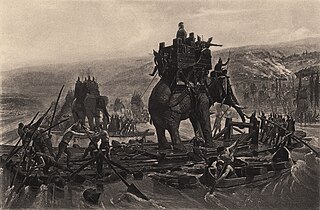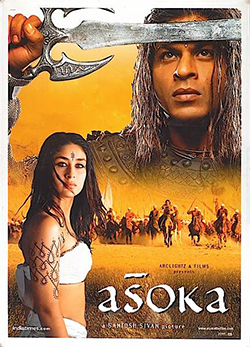
Ashoka, popularly known as Ashoka the Great, was the third Mauryan Emperor of Magadha in the Indian subcontinent during c. 268 to 232 BCE. His empire covered the largest part of the Indian subcontinent, stretching from present-day Afghanistan in the west to present-day Bangladesh in the east, with its capital at Pataliputra. A patron of Buddhism, he is credited with playing an important role in the spread of Buddhism across ancient Asia.

The 3rd century BC started the first day of 300 BC and ended the last day of 201 BC. It is considered part of the Classical Era, epoch, or historical period.

Chandragupta Maurya was the founder of the Maurya Empire, a geographically-extensive empire based in Magadha. He reigned from 320 BCE to 298 BCE. The Magadha kingdom expanded to become an empire that reached its peak under the reign of his grandson, Ashoka the Great, from 268 BCE to 231 BCE. The nature of the political formation that existed in Chandragupta's time is not certain. The Mauryan empire was a loose-knit one with large autonomous regions within its limits.

Chanakya was an ancient Indian polymath who was active as a teacher, author, strategist, philosopher, economist, jurist, and politician. He is traditionally identified as Kauṭilya or Viṣṇugupta, who authored the ancient Indian political treatise, the Arthashastra, a text dated to roughly between the fourth century BCE and the third century CE. As such, he is considered the pioneer of the field of political science and economics in India, and his work is thought of as an important precursor to classical economics. His works were lost near the end of the Gupta Empire in the sixth century CE and not rediscovered until the early 20th century. Around 321 BCE, Chanakya assisted the first Mauryan emperor Chandragupta in his rise to power and is widely credited for having played an important role in the establishment of the Maurya Empire. Chanakya served as the chief advisor to both emperors Chandragupta and his son Bindusara.

Bindusara was the second Mauryan emperor of Magadha in Ancient India. The ancient Greco-Roman writers called him Amitrochates, a name likely derived from his Sanskrit title Amitraghāta.

The Maurya Empire was a geographically extensive Iron Age historical power in South Asia based in Magadha. Founded by Chandragupta Maurya in 322 BCE, it existed in loose-knit fashion until 185 BCE. The empire was centralized by the conquest of the Indo-Gangetic Plain; its capital city was located at Pataliputra. Outside this imperial centre, the empire's geographical extent was dependent on the loyalty of military commanders who controlled the armed cities scattered within it. During Ashoka's rule, the empire briefly controlled the major urban hubs and arteries of the Indian subcontinent excepting the deep south. It declined for about 50 years after Ashoka's rule, and dissolved in 185 BCE with the assassination of Brihadratha by Pushyamitra Shunga and foundation of the Shunga dynasty in Magadha.

Dasharatha Maurya was the 4th Mauryan emperor from 232 to 224 BCE. He was a grandson of Ashoka The Great and is commonly held to have succeeded him as the Emperor of India. Dasharatha presided over a declining imperium and several territories of the empire broke away from central rule during his reign. He had continued the religious and social policies of Ashoka. Dasharatha was the last Mauryan emperor to have issued imperial inscriptions—thus the last Mauryan Emperor to be known from epigraphical sources.

As̅oka is a 2001 Indian Hindi-language epic historical drama film directed and co-written by Santosh Sivan. It is a dramatized version of the early life of emperor Asoka, of the Maurya Empire, who ruled most of the Indian subcontinent in the 3rd century BCE. The film stars Shah Rukh Khan as the titular character alongside Kareena Kapoor, Rahul Dev, Danny Denzongpa, Hrishitaa Bhatt, and Ajith Kumar in a special appearance. It was produced by Gauri Khan, Juhi Chawla and Radhika Sangoi. The screenplay was written by Santosh Sivan and Saket Chaudhary and the dialogue by Abbas Tyrewala. It was originally released as Ashoka: The Great in India.

Samprati was the 5th Emperor of the Maurya empire. He was the son of 3rd Mauryan Emperor Ashoka's son, Kunala and succeeded his cousin, 4th Mauryan Emperor Dasharatha, as emperor of the Maurya Empire. He built 1,50,000 Jain Derasars and made 1,50,00,000 Jain idols. He was also believed to have taken an oath to dig the foundation of a new Jinalaya every day and would not do navakrashi until it was completed.

The Kalinga War was fought in ancient India between the Maurya Empire under Ashoka and Kalinga, an independent feudal kingdom located on the east coast, in the present-day state of Odisha and northern parts of Andhra Pradesh. It is presumed that the battle was fought on Dhauli hills in Dhauli which is situated on the banks of Daya River. The Kalinga War was one of the largest and deadliest battles in Indian history.
Kunala was the Crown Prince and second son of 3rd Mauryan Emperor Ashoka and Empress Padmavati and the presumptive heir to Ashoka, thus the heir to the Mauryan Empire which once ruled almost all of the Indian subcontinent. After the departure of Mahendra, Ashoka's eldest son, he was supposed to be the heir to the empire, but was blinded by his step-mother, Tishyaraksha, at a young age in jealousy. While he was not able to take the throne, his son, Samprati, became his heir.

Dhana Nanda, according to the Buddhist text Mahabodhivamsa, was the last ruler of the Nanda dynasty of ancient India. He was the youngest son of Mahapadma Nanda.

Chandragupta is a board wargame designed by Stephen R. Welch and released in 2008 by GMT Games as part of the Great Battles of History (GBoH) series of games on ancient warfare. Chandragupta simulates battles fought by the Mauryan Dynasty in ancient India, and in so doing, attempts to illuminate the features, challenges, and unique attributes of the Indian military system and culture during this period.

The Seleucid–Mauryan War was fought between 305 and 303 BC. It started when Seleucus I Nicator of the Seleucid Empire sought to retake the Indian satrapies of the Macedonian Empire, which had been occupied by Emperor Chandragupta Maurya, of the Maurya Empire.
Durdhara was the empress consort of Chandragupta Maurya, the founder of the 4th-century BCE Maurya Empire of ancient India, according to the 12th century CE Jain text Parishishtaparvan by Hemachandra. She is stated by this text to be the mother of the second Mauryan emperor, Bindusara also known as Amitraghāta.

Chakravartin Ashoka Samrat is a 2015 Indian historical drama TV series that aired on Colors TV from 2 February 2015 to 7 October 2016. The show was created and written by author and screenwriter Ashok Banker. It stars Mohit Raina as Ashoka with Siddharth Nigam portraying the young version of the character.
The information about mother of Ashoka, the 3rd Mauryan emperor of ancient India, varies between different sources. Ashoka's own inscriptions and the main texts that provide information about his life do not name his mother. The Asokavadanamala names her Subhadrangi, while Vamsatthapakasini calls her Dharma. Different texts variously describe her as a Brahmin or a Kshatriya.

Chandra Nandini is an Indian Hindi-language historical fictional drama television series which aired on Star Plus from 10 October 2016 until 10 November 2017. It was produced by Ekta Kapoor under her banner Balaji Telefilms and directed by Ranjan Kumar Singh. Starring Rajat Tokas as Chandragupta Maurya and Shweta Basu Prasad as a princess Nandni, the story is loosely based on the life of Chandragupta Maurya.

Chandragupta Maurya is an Indian historical television show that aired on Sony TV from 14 November 2018 to 30 August 2019. Written by Raj Routh, the show is based on the life of Chandragupta Maurya, the first Mauryan emperor and founder of the Maurya Empire. The show is produced by Siddharth Kumar Tewary's One Life Studios.














